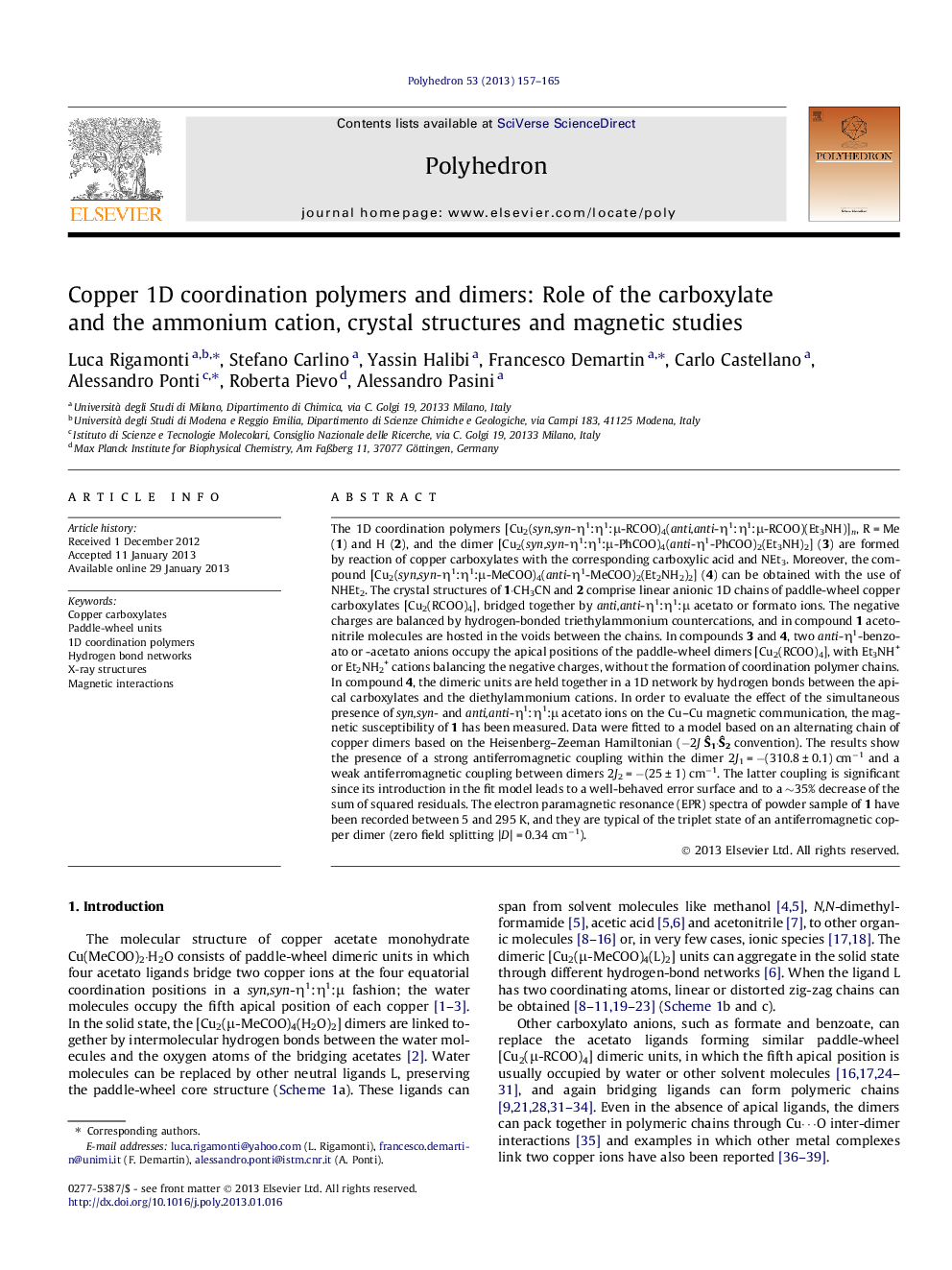| کد مقاله | کد نشریه | سال انتشار | مقاله انگلیسی | نسخه تمام متن |
|---|---|---|---|---|
| 1335807 | 1500286 | 2013 | 9 صفحه PDF | دانلود رایگان |

The 1D coordination polymers [Cu2(syn,syn-η1:η1:μ-RCOO)4(anti,anti-η1:η1:μ-RCOO)(Et3NH)]n, R = Me (1) and H (2), and the dimer [Cu2(syn,syn-η1:η1:μ-PhCOO)4(anti-η1-PhCOO)2(Et3NH)2] (3) are formed by reaction of copper carboxylates with the corresponding carboxylic acid and NEt3. Moreover, the compound [Cu2(syn,syn-η1:η1:μ-MeCOO)4(anti-η1-MeCOO)2(Et2NH2)2] (4) can be obtained with the use of NHEt2. The crystal structures of 1·CH3CN and 2 comprise linear anionic 1D chains of paddle-wheel copper carboxylates [Cu2(RCOO)4], bridged together by anti,anti-η1:η1:μ acetato or formato ions. The negative charges are balanced by hydrogen-bonded triethylammonium countercations, and in compound 1 acetonitrile molecules are hosted in the voids between the chains. In compounds 3 and 4, two anti-η1-benzoato or -acetato anions occupy the apical positions of the paddle-wheel dimers [Cu2(RCOO)4], with Et3NH+ or Et2NH2+ cations balancing the negative charges, without the formation of coordination polymer chains. In compound 4, the dimeric units are held together in a 1D network by hydrogen bonds between the apical carboxylates and the diethylammonium cations. In order to evaluate the effect of the simultaneous presence of syn,syn- and anti,anti-η1:η1:μ acetato ions on the Cu–Cu magnetic communication, the magnetic susceptibility of 1 has been measured. Data were fitted to a model based on an alternating chain of copper dimers based on the Heisenberg–Zeeman Hamiltonian (−2JŜ1·Ŝ2 convention). The results show the presence of a strong antiferromagnetic coupling within the dimer 2J1 = −(310.8 ± 0.1) cm−1 and a weak antiferromagnetic coupling between dimers 2J2 = −(25 ± 1) cm−1. The latter coupling is significant since its introduction in the fit model leads to a well-behaved error surface and to a ∼35% decrease of the sum of squared residuals. The electron paramagnetic resonance (EPR) spectra of powder sample of 1 have been recorded between 5 and 295 K, and they are typical of the triplet state of an antiferromagnetic copper dimer (zero field splitting |D| = 0.34 cm−1).
Reaction of copper carboxylates with carboxylic acids and amines gave two new 1D coordination polymers [Cu2(syn,syn-η1:η1:μ-RCOO)4(anti,anti-η1:η1:μ-RCOO)(Et3NH)]n with R = Me (1) and H (2), and two new dimers [Cu2(syn,syn-η1:η1:μ-RCOO)4(anti-η1-RCOO)2(ammonium)2] with R = Ph, ammonium = Et3NH+ (3) and R = Me, ammonium = Et2NH2+ (4); compound 1 shows a strong antiferromagnetic coupling within the dimer (2J1 = −310.8(1) cm−1) and a weak antiferromagnetic coupling between nearest dimers (2J2 = −25(1) cm−1).Figure optionsDownload as PowerPoint slide
Journal: Polyhedron - Volume 53, 10 April 2013, Pages 157–165